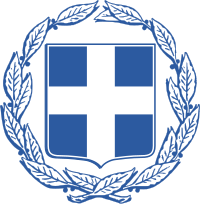Liste der griechischen Orden und Ehrenzeichen
Diese Liste gibt einen Überblick über die griechischen Orden und Ehrenzeichen.
Königreich
- Erlöser-Orden (1833)
- Ehrenzeichen für den Freiheitskampf[1]
- Denkzeichen für das Bayerische Hilfskorps[1]
- Denkzeichen für die bayerischen Freiwilligen[1]
- Erinnerungsmedaille der Verkündung der Verfassung von 1843 (1843)
- Orden Georgs I. (1915)
- Tapferkeitsorden (1915)
- Kriegsverdienstkreuz (1917)
- Phönix-Orden (1926)
- Orden des Heiligen Georg und Heiligen Konstantin (1936)
- Orden der Heiligen Olga und der Heiligen Sophia (1936)
- Kriegskreuz (1940)
- Luftwaffen-Kreuz (1945)
- Luftwaffen-Verdienstkreuz (1945)
- Kriegserinnerungsmedaille 1940–1941 (1947)
- Kriegserinnerungsmedaille 1941–1945 (1947)
- Wohltätigkeits-Orden (1948)
- Nationale Widerstands-Medaille (1948)
- Medaille für gute Dienste (1950)
- Erinnerungszeichen 100 Jahre griechisches Königshaus (1963)
Republik
- Erlöser-Orden (1833)
- Tapferkeitsorden (1915)
- Phönix-Orden (1926)
- Wohltätigkeits-Orden (1948)
- Tapferkeitsmedaille (1974)
- Medaille für gute Dienste (1974)
- Militärverdienstmedaille (1974)
- Orden der Ehre (1975)
- Kreuz für außergewöhnliche Taten (1998)
Literatur
- Arnhard Graf Klenau: Europäische Orden ab 1700, ISBN 3-921566-05-3
Einzelnachweise
Auf dieser Seite verwendete Medien
Coat of arms of Greece.svg
Wappen Griechenlands seit 7. Juni 1975.
Wappen Griechenlands seit 7. Juni 1975.
Royal Coat of Arms of Greece.svg
Coat of arms of the Kingdom of Greece in 1936–1973
Coat of arms of the Kingdom of Greece in 1936–1973
- Royal Coat of Arms of Greece under the Glücksburg dynasty, created after the restoration of King George II to the throne in 1935, to the exile of King Constantine II in 1967 and finally until the abolition of the monarchy in 1973.
- The Escutcheon features the white cross on a dark blue field of Greece. The Inescutcheon features the Arms of the Greek line of the House of Schleswig-Holstein-Sonderburg-Glücksburg. The shield is then topped with a golden Royal Crown.
- It features an escutcheon divided by the red and white cross of the Order of the Danneborg, the first quarter features the arms of Denmark (three crowned blue lions and nine hearts in yellow field). The second of Schleswig (two blue lions passant in yellow field). The third divided into four; the chief features the three royal crowns in blue field of the Kalmar Union, the second half with a crowned stockfish on red field of Iceland and the last half divided between the ram of the Faroe Islands and a polar bear of Greenland, both on blue fields. The fourth quarter is divided between two halves, the chief depicts a yellow field with a blue lion passant over nine red hearts of the King of the Goths, the lower half depicts a crowned golden lindorm on a red field of the King of the Wends.
- Upon it is another inescutcheon in red, divided into four quarters: the first a a silver nettle leaf of Holstein, the second the a swan with a golden crown of Stormarn, the third a knight dressed in golden armor on a silver horse of Dithmarschen and the fourth of a golden horse's head of Lauenburg.
- Upon it is another inescutcheon divided the first features the red and yellow bars of Oldenburg, the second a golden cross on a blue field of Delmenhorst.
- The escutcheon rests on a golden pedestal and supported by two human figures representing the Greek mythological hero Herakles (Heracles), holding a wooden club and wearing the skin of the Nemean lion.
- The escutcheon is surrounded by the ribbon and cross of the Order of the Redeemer, the cross depicts Christ Pantocrator, surrounded by the order's motto:"Η ΔΕΞΙΑ ΣΟΥ ΧΕΙΡ, ΚΥΡΙΕ, ΔΕΔΟΞΑΣΤΑΙ ΕΝ ΙΣΧΥΙ" or "Thy right hand, O Lord, is become glorious in power" from Exodus, 15:6.
- The motto of the Coat of arms and of the dynasty, depicted on a golden ribbon below the pedestal reads: "Ἰσχύς μου ἡ ἀγάπη τοῦ λαοῦ" or "The people's love, my strength"
- The coat of arms is then surrounded by a dark blue mantle and topped with another royal crown.



